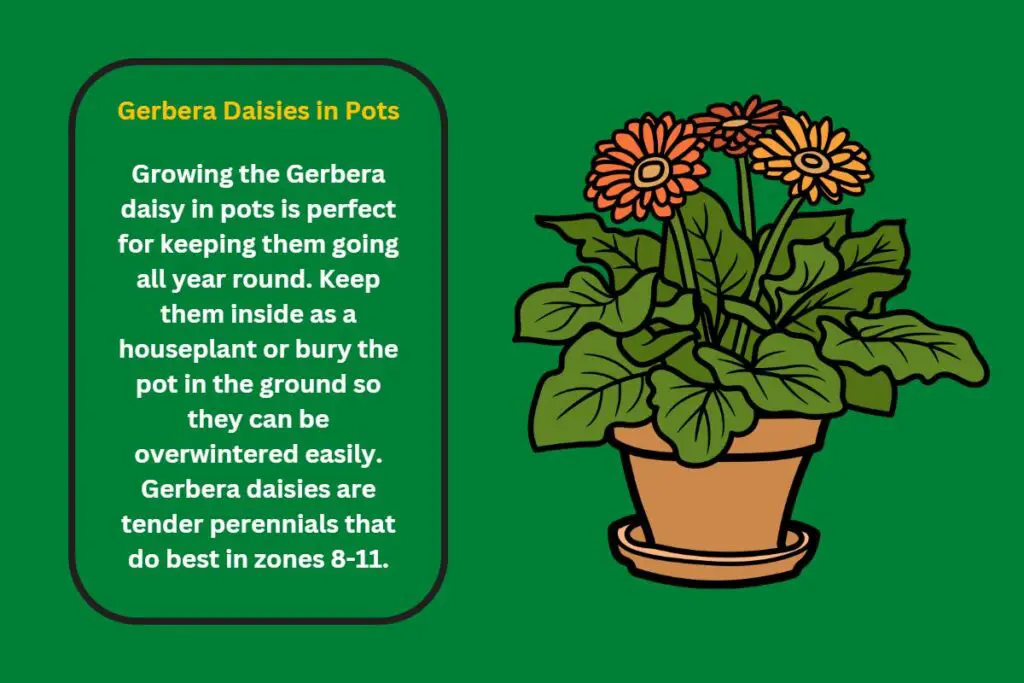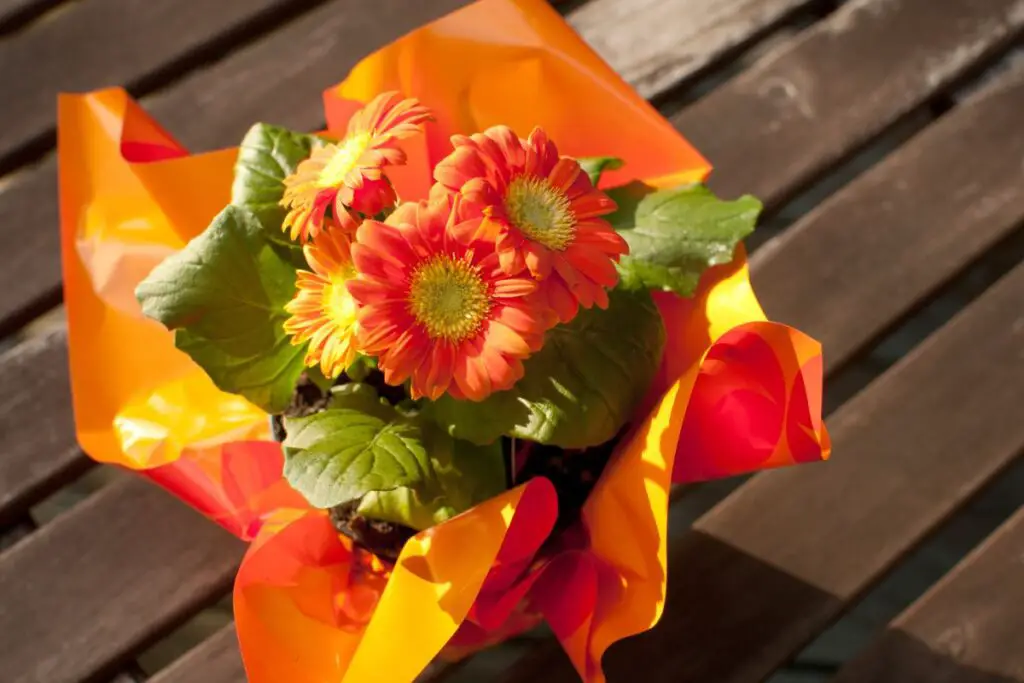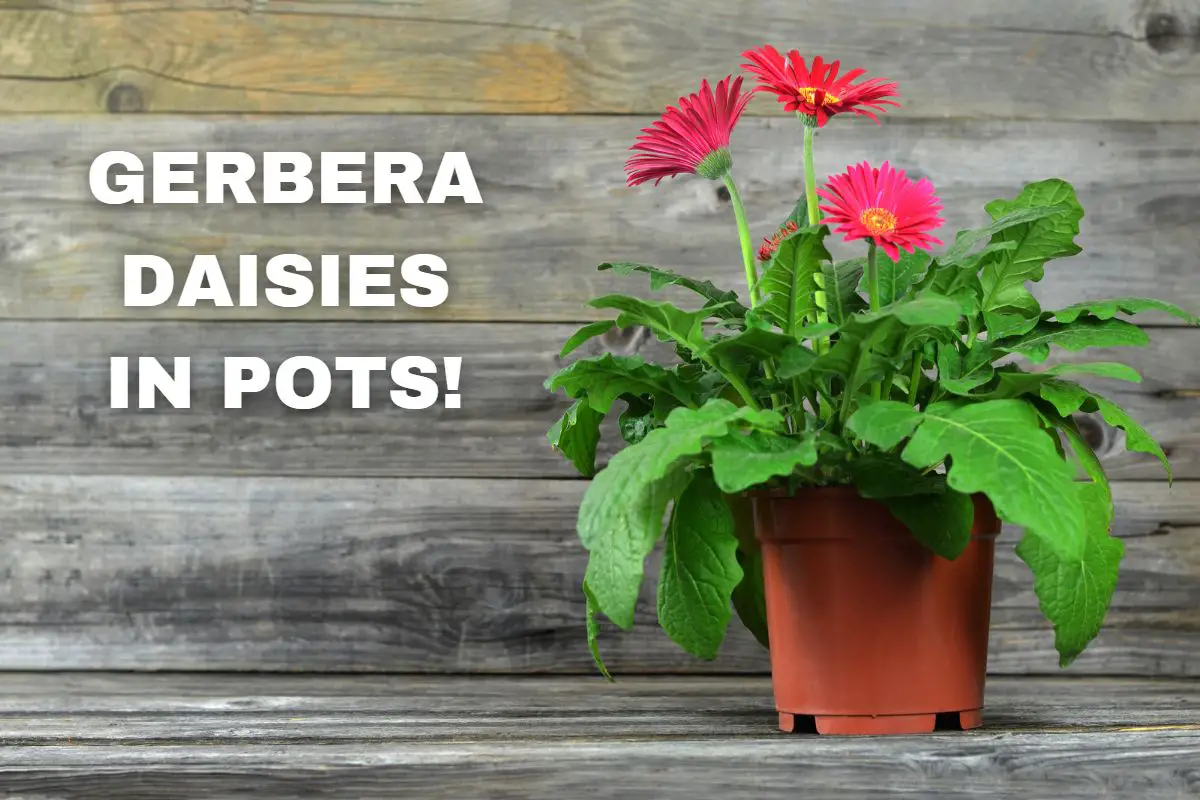Gerbera jamesonii, also known as the Gerbera daisy, is an increasingly popular plant grown for its impressive flowers. There are thousands of cultivars that can be grown in the garden or in pots and containers.
When growing gerbera daisies in pots there are some basic practices, that when observed, will give you long-lasting beauty from these gorgeous plants.
Table of Contents
Gerbera Daisy in Pots
Growing the Gerbera daisy in pots is perfect for keeping them going all year round. Keep them inside as a houseplant or bury the pot in the ground so they can be overwintered easily. Gerbera daisies are tender perennials that do best in zones 8-11.
The flowers of the Gerbera daisies come in many forms including spider, single, double, crested double, full crested double, and quilled full crested double. If that is not enough to choose from, they also come in an endless amount of colors.
Most come in radiant forms of yellow, orange, pink, and red. They also come in lighter shades like peach, lavender, white, and many, really cool, bicolored variations.
With so many variations, the Gerbera daisy finds a place in our homes and gardens with ease. Many dwarf varieties are available for planting in pots, and given the right size container, all can be grown in pots successfully.
With proper soil, water, light, and temperature conditions, Gerbera daisies grown in pots can bring years of enjoyment.

Best Soil For Gerbera Daisies in Pots
Whether grown in containers or in the ground, Gerbera daisies need rich, well-draining soil that is not too heavy. Your standard potting soil or potting mix will work well when planting your Gerbera daisies in pots.
Many potting mixes will contain some amount of fertilizer, although this will vary greatly depending on which one you choose. Cheaper potting mixes will often contain a large amount of bark and wood chips.
When planting your gerbera daisies in whatever potting soil you’re going to use, it is recommended that the mix contains 20%, or less, of these “forest products”. That being said, it may be necessary to sift through the potting mix, removing some of the larger chunks of wood.
Of course, you can always make your own potting mix using peat moss (or coconut coir), compost, and perlite (or vermiculite). Your basic garden mix will use one-third of each. For growing Gerbera daisies indoors, you will want to modify this mixture to get the most out of your plants.
But you’re in luck because I’m going to share my ultra-secret homemade potting mix recipe that works great for growing gerbera daisies in pots.
Potting Mix Recipe for Gerbera Daisy
My recipe for a Gerbera daisy potting mix goes like this:
- 2 parts peat moss or coconut coir
- 1 part perlite or vermiculite
- 1 part compost or well-rotted manure
- 1 part sand
- 1 tablespoon of lime or dolomite per gallon of mix
- 1 cup of slow-release fertilizer per cubic foot of mix
Peat moss and coconut coir provide moisture retention and aeration while the perlite and vermiculite improve drainage with added aeration. The compost or manure adds nutrients to the soil mix and the sand further improves drainage and aeration.
Gerbera daisies prefer slightly acidic soil with a pH of 6.0 to 6.5. This is where the lime or dolomite comes in.
Fertilizer for Gerbera Daisies in Pots
Whether you’ve bought your gerbera plant, or plants, already potted, used a commercial potting mix from your local hardware store or gardening center, or made your own, it will have enough nutrients to get your plant by while it puts on its first flush of flowers.
After that, it is a good idea to fertilize every couple of weeks to promote healthy growth and keep the blooms coming one-after-another throughout the growing season. The first flush of flowers can last for up to six to eight weeks.
When you’re growing Gerbera daisies in pots, there’s no guarantee that you’ll get a second flush of flowers. However, regular fertilizing and deadheading can give you the best chance of getting your plant to rebloom, not only this season but the next one as well.
See our article for How To Keep Gerbera Daisies Blooming
A water-soluble, low-phosphorus fertilizer with nitrogen, phosphorus, and potassium, such as a 24-8-16 formula is going to work the best. Make sure you dilute the fertilizer, closely following the instructions on the label.
See our article for Deadheading Gerbera Daisies
Watering Gerbera Daisies in Pots: How Often and How Much
When you have your Gerbera daisies established in pots with well-draining soil, you want to make sure to water them regularly. Saturate the soil with water and wait until the top 1 inch of soil is dry before giving them more water, anywhere from three to five days.
Make sure not to overwater them as they are susceptible to root and crown rot. Always water your Gerbera daisies from the crown of the plant, underneath the leaves. This helps keep the plant free from infection and prevent fungal problems like powdery mildew.
Light Requirements for the Gerbera Daisy in Pots
Gerbera Daisies require a lot of light to grow all those gorgeous blooms, however, they dislike intense heat. Try to find a sunny spot for your gerberas next to a window where they can get some direct sunlight in the morning and some indirect sunlight in the afternoon.
They grow very well with temperatures ranging from 70°-75° F. As long as they are not directly in front of a window where the sunlight is scorching their leaves, they will do just fine.
When they are growing in pots outdoors, the same is true. Place them in a spot that gets morning sun and dappled shade throughout the afternoon. When kept indoors, supplementing their light conditions with artificial light can give the plant the light it needs and keep it within the temperature range it desires.
Choosing the Right Pot for Your Gerbera Daisies
Gerbera daisies work in a variety of pot sizes. A small starter plug or 6-inch pot can be used for seed starts. Once the plant starts to develop, move it into a larger pot.
If you’ve purchased your Gerbera daisy already potted, it may be necessary to repot it before the next growing season. When your gerbera daisy has grown over the edge of the pot and it seems a little crowded up top, then most likely the same thing is happening below the surface.
As your Gerbera Daisy matures, the roots run out of space and the plant becomes root bound. Try to place the plant in a larger container before this happens. The more room the roots take up inside the container, the less room there is for the soil to hold water.
This can stunt the plant’s growth and bring about its overall demise. If the foliage doesn’t look healthy, or the plant is not flowering, this may be the cause. Most pots will only be large enough to support one plant, but larger containers can hold two or even three plants.

Common Problems and Solutions for Gerbera Daisies in Pots
Insects can be a problem for your Gerbera daisies. The first line of defense in keeping them bug-free is to keep them as healthy as possible by pruning away any damaged or old leaves and flowers, having them in a large enough container, and using fertilizer during the growing season.
Pests that you’ll want to keep an eye out for are leafminers, thrips, aphids, spider mites, and whiteflies. In the case of leafminers, simply remove the damaged leaves and dispose of them somewhere they will not spread to other plants either inside or out.
Treating your Gerbera daisies with insecticidal soap or neem oil extract will take care of most other pest problems. Avoid overwatering to keep root or crown rot and powdery mildew at bay.
Overwintering Gerbera Daisies in Pots: Tips and Tricks
Gerbera daisies can be sensitive to the effects of transplanting. Moving them from the ground to a pot that you can keep away from freezing temperatures is possible, however, doing so can be a gamble as the plant may not survive the move.
Keeping your Gerbera daisies in a cheap plastic pot that can easily be placed inside a more attractive container and placing the plant, pot and all, in your garden gives you the best of both worlds when it comes to giving them winter shelter while still displaying these gorgeous plants in the ground with the rest of the group during the growing season.
Because these plants don’t tolerate frost or freezing temperatures, keeping them in the pots makes moving them indoors or to another suitable area a snap.
Plan ahead and make sure to move them before nighttime temperatures drop below 40°. Taking the plant outdoors during the day where it can get the sunlight that it wants can help the plant acclimate to its new environment and improve its chances of survival.
Treating them as any other houseplant, giving them adequate light and frequent watering, can provide the possibility to keep them blooming throughout the winter. Conversely, you can let them go into their naturally dormant state for the winter.
When performing the latter, the gerbera daisy will require less water and sunlight. Water your gerbera daisies every 5-7 days ensuring that the bottom half of the container stays moist. Three hours or more of direct sunlight will be enough to get them through the winter until they are ready to go outside next spring.
Want to learn more about gerbera daisies? Find out if Gerbera Daisies are Annuals or Perennials!
Related Questions
How long do potted Gerbera daisies last?
Gerbera daisies in pots can last two or even three years. Give them adequate water and sunlight. Fertilize with a liquid fertilizer every two weeks in the spring, summer, and fall, and repot them if they outgrow their container.
How do I prevent pests and diseases from affecting my Gerbera daisies in pots?
You can prevent pests and diseases by ensuring that your Gerbera daisies are growing in well-draining soil and receiving adequate sunlight. You should also avoid overcrowding the pots as this can create a humid environment that attracts pests and diseases. It can also be a good idea to spray the plants with insecticidal soap or a neem oil solution to keep pests at bay.


